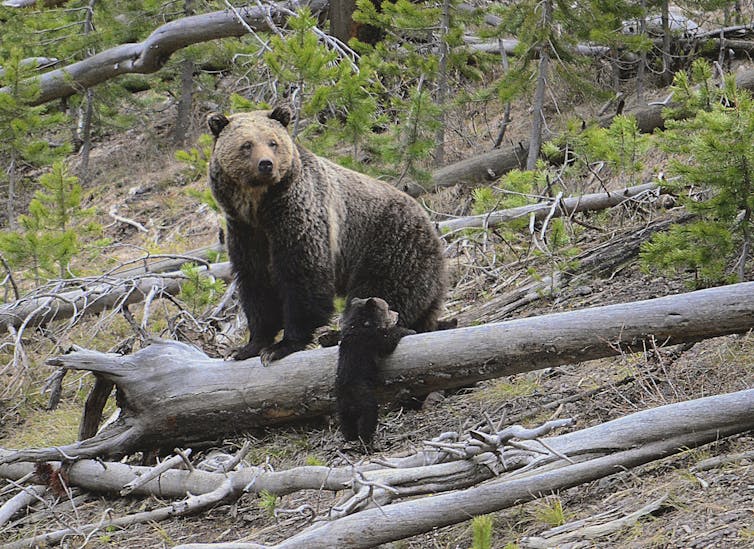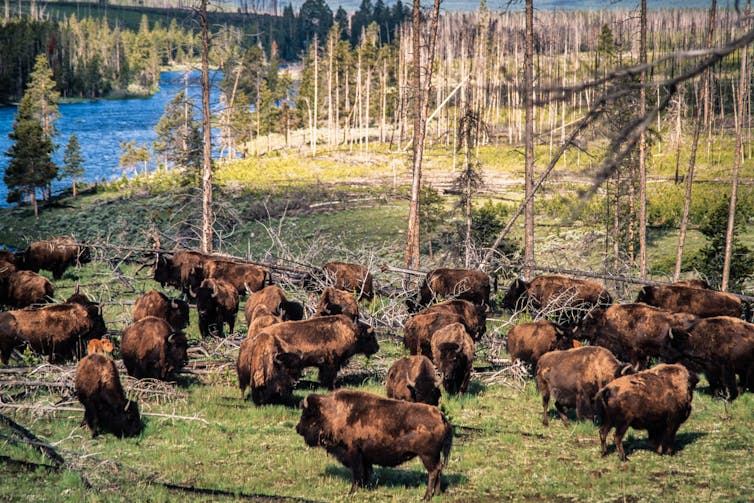For decades, wildlife conservation policy has aimed to protect endangered species until there are enough individual animals alive that the species won’t go extinct. Then the policymakers declare victory.
That principle is enshrined in laws such as the U.S. Endangered Species Act and Canada’s Species at Risk Act. It shapes how governments manage wildlife and their habitat, how politicians weigh trade-offs between species protection and human development goals, and how the public understands conservation.
But often, those minimalist population numbers – enough to avoid extinction – aren’t enough to restore ecosystems or cultural connections between people and those animals.
There’s another way of thinking about species recovery: emphasizing not just avoiding extinction but instead enabling species to truly thrive. A shift from conserving minimum populations to restoring thriving populations involves recovering the species’ ecological role, including large parts of its geographic range and genetic diversity, as well as its relationships with people.
The difference between recovering thriving populations instead of traditional minimalist approaches becomes clear when looking at three iconic North American species: gray wolves, grizzly bears and bison.
National Park Service via AP
Gray wolves: More than a number
After decades of federal protection, gray wolves were taken off the list of species protected by the Endangered Species Act in parts of the U.S. in January 2021.
The Trump administration is considering removing federal protections for gray wolves nationwide.
But in the wake of the regional protection removal, states such as Montana and Idaho expanded hunting and trapping seasons for wolves, and some organizations added bounties for killing them.
Officials justified their actions by pointing to the fact that gray wolves had surpassed a minimum population threshold for species survival, and saying that intensive predator control would not jeopardize the species’ long-term viability.
The states’ current population goals would reduce wolf populations to about one-third of current numbers: from 1,235 to 500 in Idaho and from 1,134 to 450 in Montana.
For contrast, there are 3,300 wolves in Italy. That country has an area about 80% of the size of Montana and is home to less prey, less open land and more than 50 times as many people, all of which significantly raise the potential for human-wolf conflict.
So far in Idaho and Montana, gray wolf numbers have stopped increasing and may still satisfy requirements under federal laws protecting the species. But the wolf population there is not robust and thriving – it’s just surviving.
Wolves remain absent from large areas that provide suitable habitat for them. Reducing wolf numbers further, as the states want to do, would limit their ability to reoccupy these areas, where they could restore ecosystems by helping to manage often overabundant prey populations and also inspire millions of people with their wildness.

United States Geological Survey via AP
Grizzly bears: Viable yet vulnerable
Grizzly bear populations in the Greater Yellowstone and northern Continental Divide ecosystems have exceeded the federal recovery targets set decades ago under the Endangered Species Act to prevent the bears’ extinction.
In July 2025, a U.S. House of Representatives committee agreed to remove the species’ protection under the law, which would allow states to permit people to hunt the bears for the first time in decades. But it was overhunting that, in part, drove them to near extinction in the first place.
Government agencies often say that hunting and trapping reduce human conflicts with bears. But scientific and public opinion on that point is far from a consensus. There are effective, nonlethal methods for keeping bears away from humans, such as public education, electric fencing, bear-resistant garbage containers and removal of roadkill and dead livestock.
Once numbering more than 50,000 across at least 18 states in the 48 contiguous United States, grizzlies now number just over 2,000 and occupy less than 5% of their original habitat area. They can be found in only four states.
Current grizzly populations are also not interconnected, despite the availability of suitable habitat for them. That risks genetic isolation of subpopulations, which decreases genetic diversity and their prospects for adaptation and survival. Disconnection of populations also reduces their ability to disperse seeds, improve soil health and prey on other species. Grizzly bears are also an umbrella species, meaning they share habitat with a disproportionate number of other species, so recovering grizzlies benefits the entire food web.
One day, hunting might offer a new way for humans to reconnect with thriving grizzlies. But right now, with populations isolated and vulnerable, opening a hunting season would risk cutting off their chance to thrive in large, unoccupied ranges.

Jon G. Fuller/VWPics/Universal Images Group via Getty Images
Bison: The illusion of return
Perhaps no species better captures the failure of existing recovery models to move beyond survival toward thriving populations than the bison. Tens of millions of them used to roam North America, shaping grassland ecosystems and playing significant material, spiritual and communal roles in Indigenous cultures.
Hunting for bison hides and tongues reduced their numbers to fewer than 1,000 at the cusp of the 20th century. Today, most bison live on ranches in small, fenced herds. Only 31,000 bison in North America are managed for conservation, and most are in isolated pockets of habitat at the fringe of their historic range. Even in Yellowstone National Park, which supports thousands of bison and provides a glimpse into how bison historically shaped North American ecosystems, the animals are barred from expanding to other parts of their historic range due to concerns about disease transfer to domestic livestock.
Thinking about the bison’s recovery in different terms does not mean tens of millions of them need to be stampeding across the continent. But it could mean large, free-ranging, genetically diverse herds that are integrated into a variety of ecosystems, where they also have a role in cultural revitalization.
A thriving view of species recovery is central to Indigenous-led initiatives, such as those guided by the 2014 Buffalo Treaty, which has been signed by more than 40 Indigenous nations. The treaty helped drive bison reintroduction to Banff National Park in Canada and is currently inspiring the recovery of free-roaming bison on Indigenous reservations across the U.S. and Canada, including the Blackfeet Reservation in Montana and Wind River Reservation in Wyoming.
A broader vision of recovery
Shifting away from the long-standing goal of a minimum viable population would require changes to how recovery targets are set, how success is measured, and how decisions are made when populations reach those minimum thresholds.
While national laws in the U.S. and Canada provide valuable starting points, focusing on species not just surviving but thriving would involve more ambitious goals, longer timelines and stronger human-wildlife coexistence measures. It would also require shifting public expectations away from the idea that recovery ends when minimal legal obligations are met.
Doing so could help combat climate change by restoring the role of large, wild animals in nutrient cycling, as well as reverse ecosystem degradation and help people of all backgrounds reconnect with nature.
As wildlife biologists, we aim to provide the best available science and recommendations to inform the conservation of North America’s wildlife. Yet under the current management paradigm, where recovery often equates to mere survival, we are compelled to ask whether this is enough. Should wildlife conservation aim merely to prevent extinction or to foster populations that thrive? How each and every one of us answers this question will shape not only the future of wolves, grizzly bears and bison, but also the legacy of wildlife recovery across North America.
